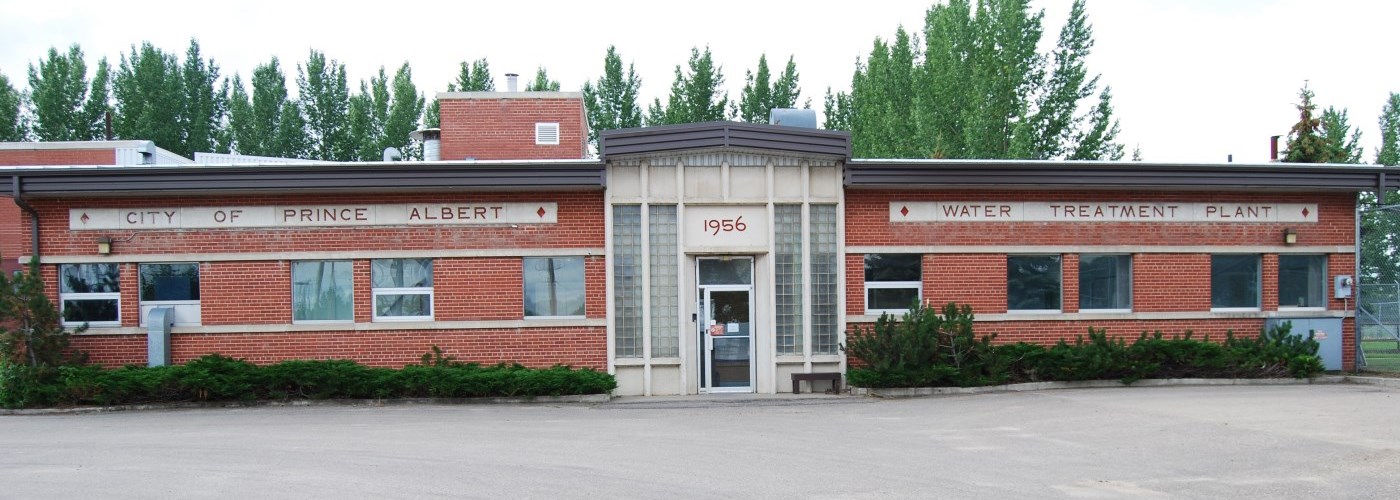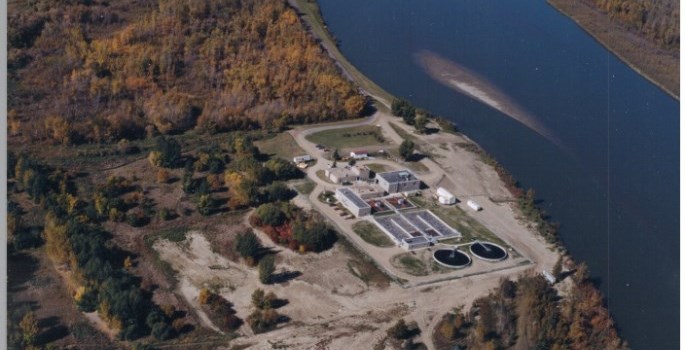Water System Infrastructure |
|
Raw water is drawn from the North Saskatchewan River through the new Raw Water Pumphouse built in 2022. The existing Water Treatment Plant was constructed in 1956 at its current location at 655 River Street West. In 1962 the Second Avenue Reservoir was constructed primarily to service the expanding City to the south and specifically the distribution system in the upper zone above the river flats. In 1980 the Marquis Road Reservoir was constructed to meet further demands on the system as the City continued to expand south. Then in 1988 the River Street Reservoir was constructed next to the Water Plant which also received a major expansion with new clarifiers in 1989. Further water treatment plant upgrades took place in 2013 with upgraded clarifiers and filters. In 2017 and 2018 both the 2nd Avenue and Marquis Road Reservoirs and Pumphouses received a full rehabilitation. Finally in 2019 a second River Street Reservoir and a new Pumphouse was constructed next to the Water Plant. |
Water Treatment Plant Process |
|
Preliminary settlement of suspended solids, screening, and potassium permanganate (KMnO4) injection takes place at the Raw Water Pumphouse prior to the water being pumped to the Water Plant. Once the water enters the Plant it is dosed with coagulant and mixed utilizing hydraulic jets mixers prior to being discharged into the first of three contact basins. Powdered activated carbon (PAC) can be added to any of the contact basins but is typically added in the third basin. The water then enters the dual train of high rated ballasted flocculation ACTIFLO clarifiers where the water is dosed with micro-sand and polymer in the series of coagulation, maturation, settling and recycle tanks. Once the water has been processed in the ACTIFLO, the clarified water is dosed with a small amount of coagulant then sent to the filters. Prior to entering the gravity filters chlorine is dosed to minimize bacterial growth within the filters. The Filtration consists of four dual media gravity filters. The finished treated water then passes through UV reactors and chlorine to provide disinfection, then dosed with caustic soda for PH control and sodium fluoride before finally being sent to the River Street Reservoir for storage. It is then sent as required to the Pumphouse for distribution to the City. The Water Plant can treat 33 Million liters per day. The Water Plant meets all Federal and Provincial Water Quality Regulations. Water quality results can be viewed in the Annual Notice to Consumers. Click below to view previous annual reports. |
Water Reservoir Storage |
|
Water Distribution System |
|
Sewage System Infrastructure |
|
The Waste Water Treatment Plant was constructed in 1972 at its current location at 2000 1st Street East, 6 km downstream of the Water Plant. In 1986 an expansion to the chlorine storage building was completed. In 1999 the plant was upgraded to a secondary process with the addition of an activated sludge system. Then in 2009 the chlorination system was replaced with a UV disinfection system. The new process was designed to reduce pathogens in the effluent discharged into the North Saskatchewan River. Finally In 2014 the headworks screens were upgraded. |
Waste Water Treatment Plant Process |
|
Waste is collection in the sewer mains and gathers at lift stations. There are twelve sewage pumping lift stations located throughout the city. Age of the original stations varied but date as far back as 1956. All stations received full rehabilitation from 2015 to 2017. Raw sewage is pumped into the sewer trunk mains that eventually enters the Waste Water Treatment Plant. Sewage then enters the headworks, where it is screened and pumped to the primary clarifiers. Sewage is retained in the clarifiers for a period to allow for heavy solids to settle to the bottom and buoyant material to rise to the top. Settled solids are drawn from the bottom of the primary clarifiers and pumped into a de-gritting unit. The heavy grit that is separated is deposited in a bin and de-gritted sludge flows into a gravity thickener. Thickened sludge is pumped to the belt filter press for dewatering and transport to the landfill. Liquid effluent from the primary solids thickeners flows back to the primary basins. The effluent from the primary clarifiers and thickener flows into the bioreactors where it is mixed with Return Activated Sludge (RAS) and is aerated to reduce Biological Oxygen Demand (BOD) and organic content of the wastewater. The Bioreactor effluent goes into the secondary clarifiers. The effluent from the secondary clarifiers flows to the UV building where it passes through redundant banks of UV lamps to disinfection of bacteria prior to discharge into the North Saskatchewan River. The Waste Water Plant can treat 44.4 Million liters per day. The Waste Water Plant meet all Federal and Provincial Water Quality Regulations. |
Sewage Collection System |
|
Storm Water Infrastructure |
|
The Storm water from spring runoff and summer rains are collected in catch basins throughout the City and transported by storm mains to trunk storm mains that either empty into the Storm Channel, Retention Ponds and/or to outlets into the North Saskatchewan River. In the south and east side of the City there is Storm Channel constructed in 1976 and rehabilitated in 2017 that collects rain water and delivers it to the River. In the south and west side of the City there is are two Retention Ponds, West Hill Pond constructed in 2010 and Lake Estates Pond in 2013 that hold water temporarily until storm mains can safety transport rain water to the river. These ponds also act as center pieces for parks. There are 33 storm outfalls into the river all of which were rehabilitated in 2015. The existing Storm system has a calculated design to accommodate a 2 year, 1 hour rainfall event with an average intensity of 17mm per hour. Since 2015 City Design Standards require all new storm mains to accommodate a 1 in 5 year rainfall event 24mm per hour. |
Storm Collection System |
|
Water Quality – Annual Notice to Consumers
2024 Annual Notice to Consumers
2023 Annual Notice to Consumers
2022 Annual Notice to Consumers
2021 Annual Notice to Consumers
2020 Annual Notice to Consumers
2019 Annual Notice to Consumers
2018 Annual Notice to Consumers
2017 Annual Notice to Consumers
2016 Annual Notice to Consumers
2015 Annual Notice to Consumers
Municipal WaterWorks Financial Ratio
The following information required pursuant to section 22.5 of the Cities Regulations is available for inspection at City Hall during regular office hours:
- Waterworks rate policy and capital investment strategy
- Waterworks financial overview
- Current reserves
- Most recent waterworks independent engineering assessment
- Capital plans for waterworks infrastructure projects and sources of funding
Please contact Financial Services at 306-953-4350 if you would like to view this information, it is also available in electronic format in the Annual Report.





